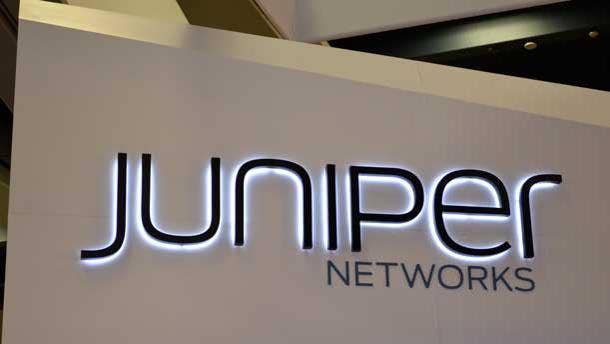Juniper Networks CEO Rahim On 5G, SD-WAN, And The Drive To Rule The Multi-Cloud World
Juniper Networks CEO Rami Rahim is positioning his company to capitalize on the move to 5G, cementing an open, end-to-end strategy for multi-cloud architectures and making sure that Juniper's SD-WAN strategy is part of that holistic end-to-end formula.

The Challenger
Juniper Networks CEO Rami Rahim isn't jumping on any bandwagons.
The red-hot market for SD-WAN is a huge opportunity, but "I still think there's a lot more talk than there is actual action in deployments," Rahim said in an interview with CRN. Cloud repatriation may be happening, "but I honestly don't think it's enough to call it a trend," he said.
Still, while the 21-year Juniper veteran may be averse to chasing trends, he is placing bets. An engineer by training, Rahim is positioning Sunnyvale, Calif.-based Juniper to capitalize on the move to 5G, cementing an open, end-to-end strategy for multi-cloud architectures and making sure that Juniper's SD-WAN strategy is part of that holistic end-to-end formula rather than just a connectivity solution.
Meanwhile, Rahim is navigating a global economy and IT market that offers both undeniable opportunities and significant challenges.
"We've had six consecutive quarters of year-over-year growth in the enterprise," Rahim said. "Our last quarter, we saw 9 percent year-over-year growth. That's a function of our focus on enterprise customers. It's a reflection of our innovation in that space, and it's also a reflection of the economy."
The global economy may be booming, but the U.S's decision to slap a 10 percent tariff on goods made in China is a challenge, Rahim said. Juniper, like other top networking vendors, has passed on the cost of the tariff to customers, and Rahim said the company is now exploring the possibility of moving some manufacturing out of China to avoid the tariff, which is scheduled to increase to 25 percent in January.
What follows is an edited excerpt of Rahim's conversation with CRN.

What about the global economy is working in Juniper's favor? What are the challenges?
I look at it from the different customer verticals we address. On the enterprise side, the global economy is in good shape. The appetite for IT spending, the need to secure infrastructure, data, applications, workloads, the move to digitizing the workforce, the appetite for moving to multi-cloud architectures is helping. It's there, and we're taking advantage of it. We've had six consecutive quarters of year-over-year growth in the enterprise. Our last quarter, we saw 9 percent year-over-year growth. That's a function of our focus on enterprise customers. It's a reflection of our innovation in that space, and it's also a reflection of the economy. In the telco space, which is another key vertical for us, things are a little bit tougher. Service providers are gearing up for cloud services, for 5G. They're in the process of getting ready for it as opposed to being in the middle of the spend cycle. We're essentially in the mode of ensuring that we leverage our technologies and relationships we have with tier one telcos worldwide to win some of these next generation opportunities. In the cloud space, hyper-scale, they're all killing it. They're taking advantage of this mass migration toward the public cloud, or to multi-cloud architectures. For the last few years, we've been benefiting from that, but over the last two or three quarters, there's been a product transition where we have an older product that is now in decline in the cloud space, and a newer product that is growing. It's a classic product transition that we're working through. Our relationships, our footprint and our relevance with the major cloud providers worldwide has never been stronger.

How long do you expect it to take for the 5G market to reach maturity, or to begin bearing fruit for Juniper?
You have telecom providers talking about deployments that will happen this year. I think the real big deployments will start more toward next year and even the year after. It will mostly be in the U.S. and in certain parts of Asia. The preparatory work for 5G is starting today. 5G is inherently a cloud-native architecture. The services that will be delivered over 5G, the back-end functions are inherently virtualized and need a distributed data center architecture that will deliver these services to the end user. It's incumbent upon these operators to start the investment in cloudifying their network today in anticipation of 5G. We all know 5G is going to drive incredible amounts of capacity in the network. It's going to result in low latency, and that requires special build-outs, and we're starting to see some of the projects in anticipation of 5G in these areas come to fruition today.

How much cloud repatriation are you seeing, and what does that mean for Juniper?
I have seen a couple examples, but I honestly don't think it's enough to call it a trend. If anything, it's still more of the reverse. There is a much more balanced view today than there was maybe a year or two ago where the thought was everything was going to move to public cloud. More realism has come into the picture, and most CIOs of Fortune 1000 companies are pragmatically thinking about a hybrid- or multi-cloud architecture. They want to reap the advantages of the capabilities public cloud offers them, but they don't want to do it in such a way that they are completely locked into a single public cloud provider. And they understand that for a variety of reasons, whether it's regulatory, security, compliance, they're going to need to preserve some applications and workloads in private cloud. It's easy to say, but it's much more difficult to do. Each of the different public clouds and private clouds offers a different set of automation capabilities, security policy capabilities. They need a solution to extract away the complexity and to provide the peace of mind that they can have a similar security posture across all these different environments. That's an unsolved problem, at least it's not solved well today. It's the problem that we're out to address with our product offerings, mainly with Contrail Enterprise Multi-Cloud, which we introduced this year. Based on initial updates from our customers, I believe we're onto something.

How does Juniper intend to balance the need to offer complete solutions on one hand and the need to work with every other vendor on the other?
Juniper, by our nature, from the very start of the company, we truly value open architectures. That means interoperability, and the recognition that many of our customers are going to want a multi-vendor environment, solutions using best-of-breed technologies, and that's in our DNA. For a challenger like Juniper, that's a good thing. It gives us the opportunity to go to our customers and insert ourselves in a specific part of a solution. That impresses our customer. We can demonstrate how value we can add, how strategic we can become. What we find is we grow into more and more use cases from there. That's typically how we get inserted into new customer opportunities. We're even open-sourcing parts of our software portfolio. It gives us a level of flexibility. At the same time, we're also becoming enough of a trusted advisor for many of our customers where they don't want to sacrifice the openness of our architecture, but they do want to look at us as an end-to-end solution provider. A tier one telecom operator wanted to deliver a brand new service offering to their customers. They wanted to do it using a virtual services offering, and ultimately called on Juniper to deliver the entire cloud stack, the management and orchestration capabilities, which we will build, test, operate and then transfer. We have a similar example happening on the enterprise side. Our ability to show up with a services offering, and also the ability to do the testing, the build and operate helps tremendously.

What has been the impact of the U.S. tax cuts on your customers? Has willingness to spend on IT increased? Are budgets healthier?
The appetite of our customers, especially in the enterprise space, to invest in modernizing their infrastructure to the cloud, to digitize their work environment, is looking good. It's healthy, and I do believe the tax cuts benefited that in some ways.
What's your strategy around the U.S.'s tariffs on Chinese products?
It's not much different than what our peers are doing. We are looking at any and all opportunities to mitigate the costs associated with the tariffs. We've already made some changes to our supply chain to deal with it, and we, like our peers in the industry, will have to pass along some of the increases in tariffs to our customers as we're working through additional mitigation strategies.
Does 'changes to our supply chain' mean you'll be sourcing things from places other than China?
Where it's possible. These things can't happen overnight, but we're certainly looking at that approach, yes.

What's your strategy for the SD-WAN market?
It's a big opportunity. It's an emerging opportunity, and I still think there's a lot more talk than there is actual action in deployments. The potential for the SD-WAN market to become huge is absolutely there. We took a bit of a different approach. We took our time. We didn't jump in early because we fundamentally believe that the SD-WAN market as perceived initially is just too narrow a view. SD-WAN just to solve the connectivity problem is just not all that interesting, and not what I believe to be the really compelling attribute of SD-WAN in the future. We took the time to build a solution that is inherently embedded in the end-to-end architecture. We made sure our solution gave you maximum scalability. It's not just about winning the first three branches; we wanted to make sure – especially with who our customers are – that when we win an account that has literally thousands and thousands of branches, that we can scale up to that level of connectivity. For our customers, multi-tenancy is going to be really important. We wanted to make sure that this didn't come as just a point product, but that it gives our customers a level of openness that allows them to pick and choose different network functions and virtual network functions. They can decide to combine our SD-WAN solution with a WAN optimization solution that comes from a third-party vendor. For our customers that's really important. Not all of the capabilities I've described are considered fundamental components of SD-WAN, but we think they are fundamental components of SD-WAN. We are not first to market, but we are now offering into the market a truly compelling solution that's differentiated. We're initially working with our service provider customers such as Vodafone to offer this service to the enterprise space. More and more, we'll have more enterprise accounts ourselves.
How big a portion of your overall business do you think SD-WAN will become?
The SD-WAN market could become a $4 billion market a few years from now per analysts' expectations. Our enterprise branch business in the company today is not all that large. It's in the few hundreds-of-millions. We have an opportunity to leverage an inflection point that's happening in the market and take substantial share. We have nothing to lose by playing a very disruptive game with SD-WAN to take advantage of these next-gen branch build-outs. We have everything to gain. The key is to come to the market with a differentiated offering, and we're now at that point. I'm very bullish and excited about the opportunity.
Do you see Juniper and other networking industry challengers chipping away at Cisco's market share?
When I joined the company a couple decades ago, I was told that it would be a truly challenging task to take market share from the large incumbents and that I might consider a career elsewhere because it might be too difficult or too ambitious. I'm pretty happy I didn't listen. I think the opportunity to present compelling solutions, to leverage inflection points in the market with the goal of taking share in areas where we demonstrate real strength. We've taken substantial share in the telco space. We've taken substantial share in the cloud space over the years, and I think we can continue to do that.

What are the most important things that Juniper needs from its channel partners today?
We think that the biggest trend shaping our industry today is around cloud. In the telco space, telcos are thinking they must make this transition to become cloud providers in order to compete effectively with the cloud providers. Think about enterprises that are making this lead toward multi-cloud. Everybody is in love with the destination. Everybody knows they must transform to achieve the efficiency and the agility that cloud inevitably gives them, but very few actually have the skill sets and capabilities and technology. That presents a wonderful opportunity for Juniper, but it also is an incredible opportunity for partners that can come in with the solutions, the services, the build-operate-transfer capabilities for cloud. If our partners themselves are capable of making this skill set transition and the transformation that's necessary, then there's a huge prize for them in helping our end customers make the leap into cloud architectures.